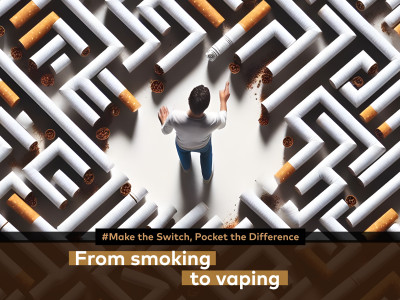As successful as vaping has been in the United Kingdom, it is generally accepted that more has to be done to reach out to the remaining 6.5 million current smokers. While some believe we should be pushing vape products more, the group of academics from the University of Bristol, University College London, and the University of Cambridge are concerned about vape products being too visible.
The researchers, including Marcus Munafò, found that most retailers that sell tobacco, albeit out of view, had prominent displays of e-cigarettes.
Tobacco products displays at the point-of-sale in retail stores are banned – but ecig displays are not. They describe this situation as “a problem”.
“The extent of this potential problem is unknown because the visibility and placement of e-cigarette and smoking paraphernalia point of sale displays has not been described in detail,” they write.
The team of researchers say they aimed to address this gap to inform future research by examining the impact of e-cigarette point-of-sale displays on tobacco smoking, particularly in children, as well as differences in visibility according to area of deprivation.
They visited 166 stores in Bristol and Cambridge, “of which 133 sold the relevant products and agreed to take part. These included small and large format stores of four supermarket chains and a randomly selected sample of convenience stores.”
The team utilised a standardised checklist to create a total visibility score for point of sale displays of e-cigarettes that were encountered, while other measures of visibility and placement were also captured.
Their results showed that both e-cigarette and smoking paraphernalia point of sale displays were present in 96% of stores. These point-of-sale displays were highly visible across all stores with an average visibility score of 14.7 out of 17 for e-cigarettes on the checklist.
Analysis of the results also revealed that the use of multiple display units was more common for e-cigarettes (53%) than for smoking paraphernalia (12%). Signage was present in most stores (62%) for e-cigarettes.
Visible pricing was present in most stores (70%) for e-cigarettes.
Most stores had smaller e-cigarette (74%) displays than their tobacco storage unit, and 49% were positioned next to it.
Just over half (53%) of stores had some form of promotional material for e-cigarettes, with the most common types involving price (23%), ease of use (15%), and flavours (14%).
The team found no link between type of display and the deprivation status of the store's location.
They concluded: “E-cigarette … POS displays are near ubiquitous and highly visible in supermarkets and convenience stores in two cities in England. The impact of these displays on tobacco smoking in children and adults is unknown, meriting urgent research to assess their effect on susceptibility to tobacco smoking in children.”
Given the extensive research demonstrating that there is no significant issue with teen vaping, that teen vaping is declining, and that teen smoking rates continue to decline, it is difficult to understand the point of their study or why they appear to labour under a misapprehension that further “urgent research” is required.
References:
- Electronic cigarette and smoking paraphernalia point of sale displays: an observational study in England - https://tobaccocontrol.bmj.com/content/early/2021/08/18/tobaccocontrol-2020-056314
Photo Credit:
Image by Dirk (Beeki®) Schumacher from Pixabay
Dave Cross
Journalist at POTVDave is a freelance writer; with articles on music, motorbikes, football, pop-science, vaping and tobacco harm reduction in Sounds, Melody Maker, UBG, AWoL, Bike, When Saturday Comes, Vape News Magazine, and syndicated across the Johnston Press group. He was published in an anthology of “Greatest Football Writing”, but still believes this was a mistake. Dave contributes sketches to comedy shows and used to co-host a radio sketch show. He’s worked with numerous vape companies to develop content for their websites.
Join the discussion
Harm Reduction For The Rich
The United Kingdom risks becoming a harm reduction country only for the wealthy, according to Michael Landl of the World Vapers’ Alliance
CAPHRA Highlights Tobacco Control Flaws
The Coalition of Asia Pacific Tobacco Harm Reduction Advocates highlights the flaws in tobacco control which has led to the rise of black market in Australia
A Missed Opportunity at COP10
The Smoke Free Sweden movement says that COP10 was a missed opportunity to save millions of lives
COP10: Promote Tobacco Harm Reduction
Experts with Smoke Free Sweden are emphasising the urgent need for a Tobacco Harm Reduction approach at COP10












